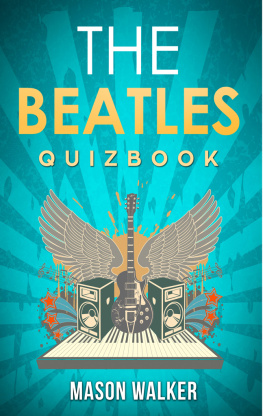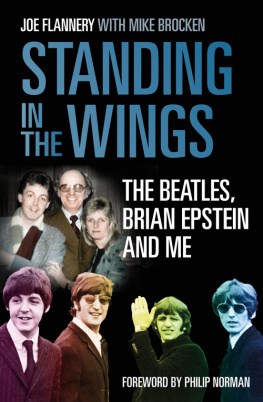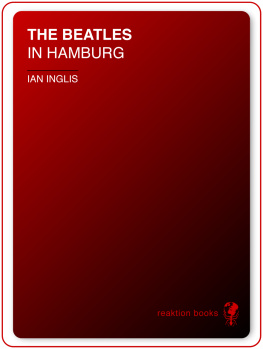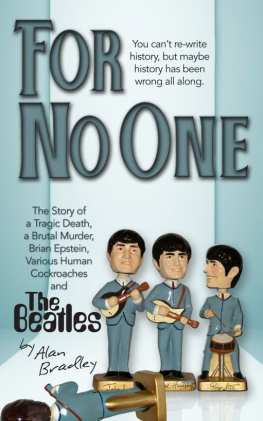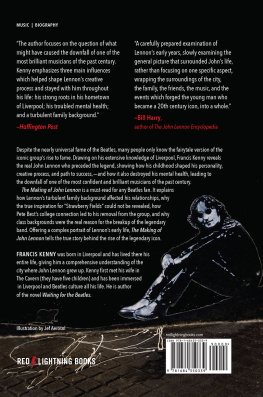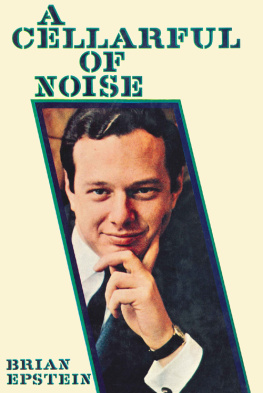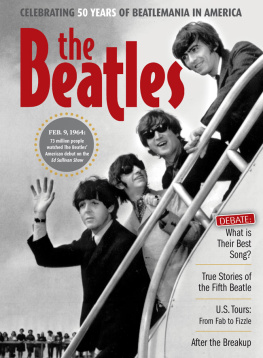WHEN
THEY
WERE
BOYS
Also by Larry Kane:
Ticket to Ride:
Inside the Beatles 1964 and 1965 Tours that Changed the World
(Running Press, 2003)
Lennon Revealed
(Running Press, 2005)
Larry Kanes Philadelphia
(Temple University Press, 2000)
Death by Deadline,
an e-book novel
(Dynamic Images, 2011)
WHEN
THEY
WERE
BOYS
The True Story of the Beatles
Rise to the Top
Larry Kane

2013 by Larry Kane
Published by Running Press,
A Member of the Perseus Books Group
All rights reserved under the Pan-American and International Copyright Conventions
This book may not be reproduced in whole or in part, in any form or by any means, electronic or mechanical, including photocopying, recording, or by any information storage and retrieval system now known or hereafter invented, without written permission from the publisher.
Books published by Running Press are available at special discounts for bulk purchases in the United States by corporations, institutions, and other organizations. For more information, please contact the Special Markets Department at the Perseus Books Group, 2300 Chestnut Street, Suite 200, Philadelphia, PA 19103, or call (800) 810-4145, ext. 5000, or e-mail .
Library of Congress Control Number: 2013938630
E-Book ISBN 978-0-7624-5095-4
9 8 7 6 5 4 3 2 1
Digit on the right indicates the number of this printing
Cover and interior design by Bill Jones
Edited by Greg Jones
Typography: Adobe Garamond and Neutra Text
Running Press Book Publishers
2300 Chestnut Street
Philadelphia, PA 19103-4371
Visit us on the web!
www.runningpress.com
To Donna, Michael, Alexandra, Doug, Jen, Aiden,
Benjamin, and Peyton
CONTENTS
There are so many people to thank, but let me start with Bill Harry, Tony Barrow, Sam Leach, Allan Williams, Yoko Ono, the staff at Studio One, Ron Ellis, Ellen Ellis, Freda Kelly, Denny Somach, Louise Harrison, Jerry Blavat, Julia Baird, and Tony Bramwell. Also thanks to Chris Carter of KLOS and XMSirius Satellite Radio, Alan White, Rod Davis, Colin Hanton, Colin Hall, Len Garry, Hunter Davies, Colin Fallows, Kathy McCabe, Mac Walter, Dave Forshaw, Sir Ron Watson, Joe Flannery, Jude Southerland Kessler, Mark Lapidos, Bruce Spizer, David Bedford, Ed Jackson, Roag Best, the White House Social Office, June Furlong, Horst Fascher, Pauline Sutcliffe, Billy Kinsley, Billy J. Kramer, John Rose, Tony Guma, Jodi Blau Ritzen, Dr. Mike Brocken, Joe Ankrah, Jonathan Davies, BBC TV, Buz Teacher, Spencer Leigh, Kevin Roach, John Gannon, Theo Somach, Jim Turner, Kevin Donahue, Marc Hudson, Joe Johnson, Andre Gardner, and Tim Riley.
Special gratitude to my family, to whom this book is dedicated; literary agent Faith Childs; the books editor, Greg Jones (this makes three books with him); and Running Press Editorial Director Jennifer Kasius, Publisher Chris Navratil, Photo Consultant Sue Oyama, Designer Bill Jones, Project Editor Annie Lenth, Tina Camma, Allison Devlin, and Gigi Lamm.
Thanks to all.
From Alpine Valley to the East Wing of the White House
When the former Richard Starkey began his rendition of Yellow Submarine, we all started to scramble, looking for some shelter from the storm on this sweltering summer night at Alpine Village in East Troy, Wisconsin. As he would sing later, It Dont Come Easy.
It was 1989, the summer that Ringo Starr & His All-Starr Band was created, and the 37,000-seat venue nestled between Chicago and Milwaukee was under attack from the gods of water and lightning. There was no place to hide as our TV team scattered backstage under canopies, under anything we could find, seeking shelter.
Three hours before, the sun was shining during the afternoon sound check when the drummer and I sat on stools on the stage, sharing, during a videotaped interview, some memories of the Beatles historic North American tours of 1964 and 1965. In the first of those unforgettable summers, I was a twenty-one-year-old newsman with a ticket to ride to cover young Ringo and his three extraordinary bandmates. It was an unlikely assignment for a man who cant hold a tune or even dance to one, but it began an odyssey, a true life adventure, that would bring me onboard not just for two summers of touring plus parts of the 1966 tour, but for a lifetime of adventure and memories.
My life experience would include fifty-six years of covering news, often having to cover my behind in some really bad and violence-filled places. My love of politics would lead me to presidents, senators, governors, mayors, and politicians of all stripes. I also went to jail, as a visitor, chronicling the life-after-political-death of many a corrupt politician. I anchored the TV news for a long time, and reported on all sorts of stories. But I would always be tethered to the one story I originally didnt want to cover. Forand this is the truthI never wanted to travel with the boys, as insiders called them early on. After all, in early 1964 I had predicted to my puzzled bosses that the mop tops, as the Beatles were unceremoniously described by the grown-ups of the time, had no real future. My talent for forecasting the future was bogus. Tell me in 1964 that I would wind up writing three books on the Fabs, as Starkey would later call them, and I would suggest that you were smoking dope, which many of you may have done at one time or another.
The interview with Ringo went well, but the skies were clouding up. By showtime it was a driving rain, like a tropical storm, and the promoters invited us to the green room, the warm and fuzzy green room, which I will forever remember as the magic room. It was there that I found out what Ringo Starr was really doing.
My wife, Donna, who rarely accompanied me to news events, was checking out the green room. Donna, who loves photography, had taken pictures of my reunion with Ringo earlier. The green room was subdued. There was an unkempt skinny guy sitting in the corner, looking lonely, sipping a Coke, and sporting a thousand-mile stare into nothingness. I introduced myself. With a sheepish handshake, he said, Im Joe Walsh. Joe Walsh of the Eagles? Yes, it was. On the other side of the room, E Street Band saxophonist Clarence Clemons had that always-cheerful look.
Not far away, munching on some food, was Dr. John, the king of the piano, the pride of New Orleans. And the hits just kept on coming in the magic room: Nils Lofgren; musician supreme, the one and only Billy Preston; drummer Levon Helm; bassist Rick Danko; and drummer Jim Keltner. Amazing, I thought. Ringo had made magic, assembling an all-star lineup of musical greats to supplement his limited repertoire. Could Ringo alone sustain a McCartney-like concert for two hours or more? Probably not. But in the process of putting together this extraordinary collection of artists, he had created a knockout concert; it was more than just a casting call to help rejuvenate stifled careers of fellow artists. For the exBeatles drummer, this was, in fact, the beginning of redemption. And it was an experience he was delighted to share.
I walked outside, under a large canopy. It was still raining. I sat down at a picnic table and started reflecting on this strange and sensational reunion between the two of us.
It dont come easy. It didnt for Starkey, aka Ringo, whom I watched slowly walk down a narrow, metal staircase, dressed in a bathrobe with a towel draped around his neck. He waved, tenderly, and smiled as he prepped for act one of the show. After all, the drummer had been given up for lost before he finally found a way to surface from oblivion. And thats why the magic room was so magic, and the evening so special. It was especially so for the men assembled in that room, the flesh and bones of stars whose spotlights had faded, legends scattered to the winds by a changing business. Some of them, like Ringo, were felled by substance abuse; others by fate. No surprise was it at all that some of the band members in this most-unusual green room were in the process of resurrection. Lazarus would have been proud.


